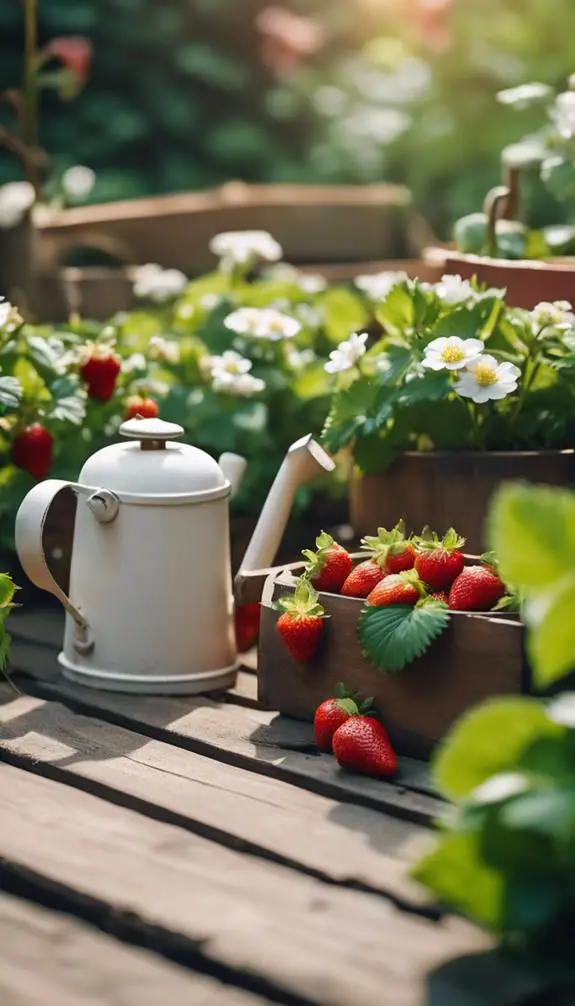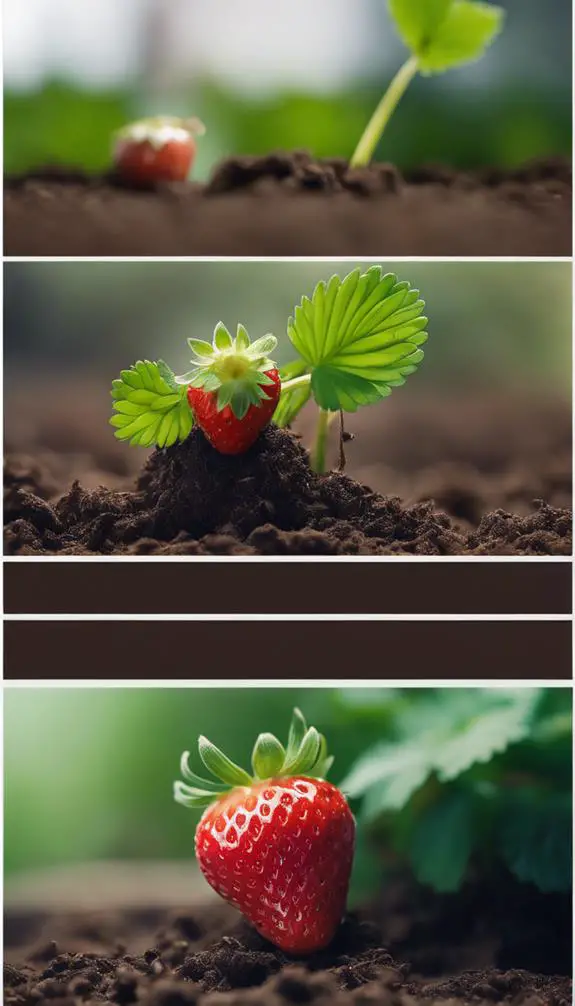As you consider growing squash in containers, you're likely wondering what it takes to succeed. With the right approach, you can enjoy a bountiful harvest of delicious summer or winter squash, even in a small space. Start by choosing a compact variety that's specifically bred for container growth, and make sure your pot has good drainage holes to prevent waterlogged soil. But that's just the beginning – you'll also need to provide the right conditions for your squash to thrive. From soil preparation to pruning and pest management, there are several key steps to master if you want to coax a healthy, productive squash plant from your container.
Summary
- Choose a container with good drainage and a minimum size of 5-7 gallons to provide enough room for squash to grow.
- Select compact or bush-type squash varieties that mature quickly (within 35-45 days) and are disease-resistant.
- Use a well-draining potting mix with a pH between 6.0 and 6.8, and add organic soil amendments like compost or well-rotted manure.
- Provide direct sunlight for at least 6 hours a day and maintain consistent moisture levels, checking containers daily.
- Prune squash vines regularly to promote healthy growth, encourage fruit production, and prevent overcrowding.
Choosing the Right Container

Selecting the right container is a crucial step in growing squash successfully in a confined space.
You'll want to choose a container that provides enough room for the squash plant's roots to grow. A minimum container size of 5-7 gallons is recommended, but larger containers will give your squash more room to thrive.
Consider decorative planters that not only add visual appeal to your space but also provide adequate drainage and aeration. Make sure the container has drainage holes to prevent waterlogged soil.
A well-draining potting mix will also help prevent root rot. By selecting the right container, you'll be one step closer to growing a bountiful crop of squash in a small space.
Selecting Squash Varieties

When selecting squash varieties for container growing, you'll want to focus on types that are naturally compact or bush-type, as they'll thrive in smaller spaces.
You'll also want to ponder varieties that mature quickly, typically within 35-45 days, to guarantee a timely harvest.
For peak space efficiency, look for varieties that are specifically bred for container growing or have a spreading habit that can be trained to climb up a trellis.
Squash Types for Containers
Among the numerous squash varieties, not all are suitable for container growing.
When selecting squash for containers, you'll want to focus on compact, bush-type varieties that produce smaller fruits. These varieties mature faster and take up less space, making them ideal for container gardening.
Consider acorn squash, crookneck squash, or pattypan squash, which thrive in containers as small as 5-7 gallons. These varieties are also more disease-resistant and require less maintenance.
When choosing a squash variety, certify it's specifically bred for container growing or has a compact growth habit. This will guarantee a successful harvest in your container garden.
Best Varieties for Space
In containers where space is at a premium, you'll want to opt for squash varieties that make the most of every inch.
Look for compact or bush varieties that have been bred for space efficiency. These varieties typically have a more compact plant habit, producing shorter vines or a more upright growth habit.
This is often achieved through advanced squash genetics, which allow breeders to select for traits like compactness and high yields.
Some popular varieties for container growing include 'Bush Baby', 'Patty Pan', and 'Round Robin'.
These varieties are specifically designed to thrive in small spaces, producing high-quality fruit without sacrificing flavor or texture.
Preparing Container Soil

With your container selected, you're now ready to focus on preparing the soil that will support your squash's growth.
Squash prefers a well-draining, fertile soil with a pH between 6.0 and 6.8. Test your soil pH and adjust it if necessary.
Add organic soil amendments like compost or well-rotted manure to improve soil structure and fertility. These amendments will provide nutrients and beneficial microbes, promoting healthy root development.
Aim for a mix that's 20% compost and 80% potting soil. Avoid using garden soil, as it can compact and prevent drainage in containers.
Sowing Squash Seeds

Squash seeds germinate quickly, typically within 3-5 days, when provided with ideal conditions.
To guarantee maximum germination, you'll want to sow fresh seeds at the correct squash depth. Plant them about 1 inch deep and 4-6 inches apart in your container soil.
Make sure the soil is warm, with a temperature of at least 65°F (18°C). You can check the seed package for specific sowing instructions, but generally, it's best to plant 2-3 seeds per container, and then thin them out to the strongest seedling once they emerge.
Fresh seeds are essential for successful germination, so use new seeds or store them properly in an airtight container to maintain their viability.
Caring for Seedlings
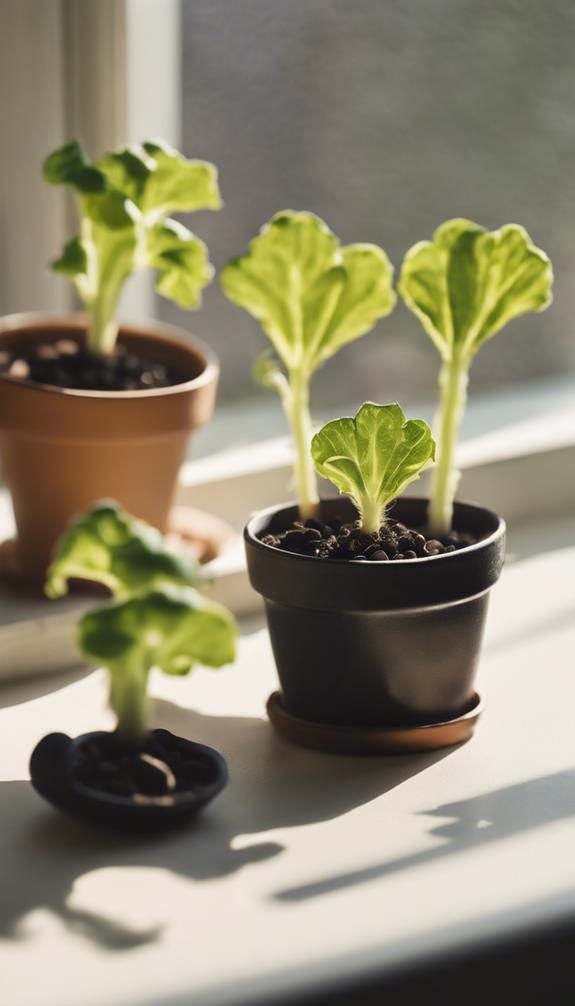
You'll need to provide the right conditions for your squash seedlings to thrive.
This includes maintaining an ideal soil temperature, as it affects root growth and development.
Soil Temperature Matters
Your seedlings' fate is closely tied to the soil temperature they're exposed to.
Squash seedlings thrive in temperatures between 65°F and 75°F (18°C and 24°C). Temperature extremes can be detrimental, so verifying soil temperature regularly is crucial.
Invest in soil testing tools, such as thermometers or temperature probes, to guarantee ideal conditions. Avoid placing containers in areas prone to temperature fluctuations, like near heating vents or air conditioning units.
Watering Young Roots
By maintaining a stable soil temperature, you've created an ideal environment for healthy root development.
Now, it's vital to guarantee consistent moisture levels to facilitate water absorption and promote root growth. Water your squash seedlings when the top inch of soil feels dry to the touch.
Avoid overwatering, which can lead to shallow root depth and reduced water absorption. Instead, provide a steady supply of moisture, allowing the roots to grow deeper into the container.
This will enable your squash plants to absorb water and nutrients more efficiently, setting them up for success in their container environment.
Providing Air Circulation
Air circulation plays a critical role in maintaining healthy squash seedlings, as it helps prevent fungal diseases that thrive in humid environments.
You can guarantee good ventilation importance by providing adequate space between containers and keeping them away from walls or other obstacles. This allows air to circulate freely around the plants.
To improve circulation methods, you can also use fans to gently blow air across the seedlings, or rotate the containers regularly to change the direction of air flow.
Additionally, make sure the container has drainage holes to prevent waterlogged soil, which can exacerbate humidity issues.
Providing Adequate Light

Squash plants require a substantial amount of light to thrive, and when growing in containers, it's essential to guarantee they receive direct sunlight for at least 6 hours a day.
You can achieve this by placing the containers in sunny spots, such as south-facing balconies or patios. Be mindful of light refraction, as it can affect the amount of light your squash plants receive.
For instance, if you're growing squash near a window, the light may be refracted, reducing its intensity. To combat this, consider using mirrors or reflective surfaces to bounce light onto your plants.
Watering Squash Plants
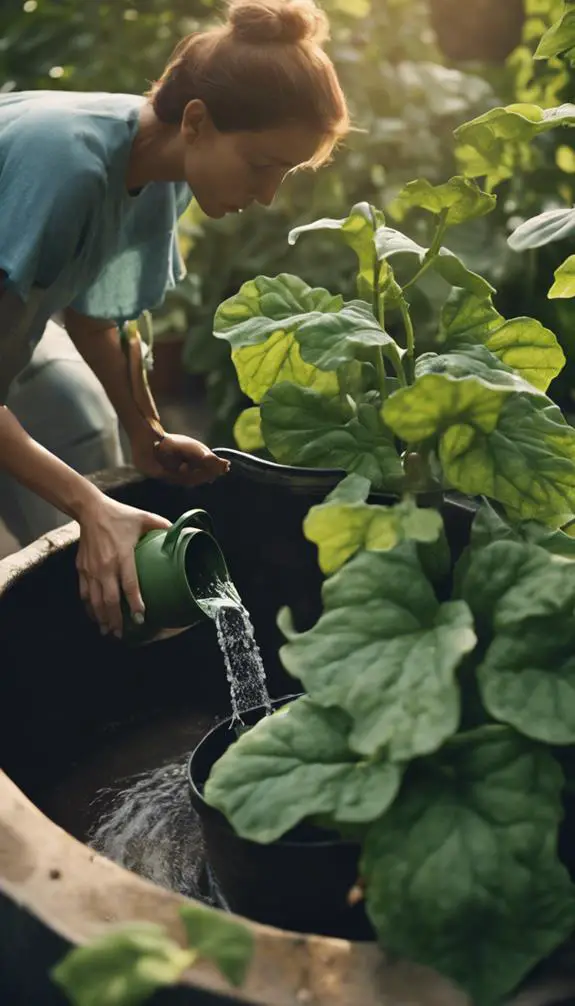
With your containers positioned in a sunny spot, you're now ready to tackle the next critical component of growing squash in containers: watering.
Squash hydration is vital, as consistent moisture levels guarantee healthy growth and fruit production. Check your containers daily, as squash plants require about 1-2 inches of water per week.
Water deeply, but avoid overwatering, which can lead to root rot and other issues. To conserve water, use a well-draining potting mix and mulch around the base of your plants.
Additionally, consider using a drip irrigation system or soaker hose to deliver water directly to the roots, reducing evaporation and runoff. By implementing these strategies, you'll optimize squash hydration while practicing water conservation.
Fertilizing for Growth
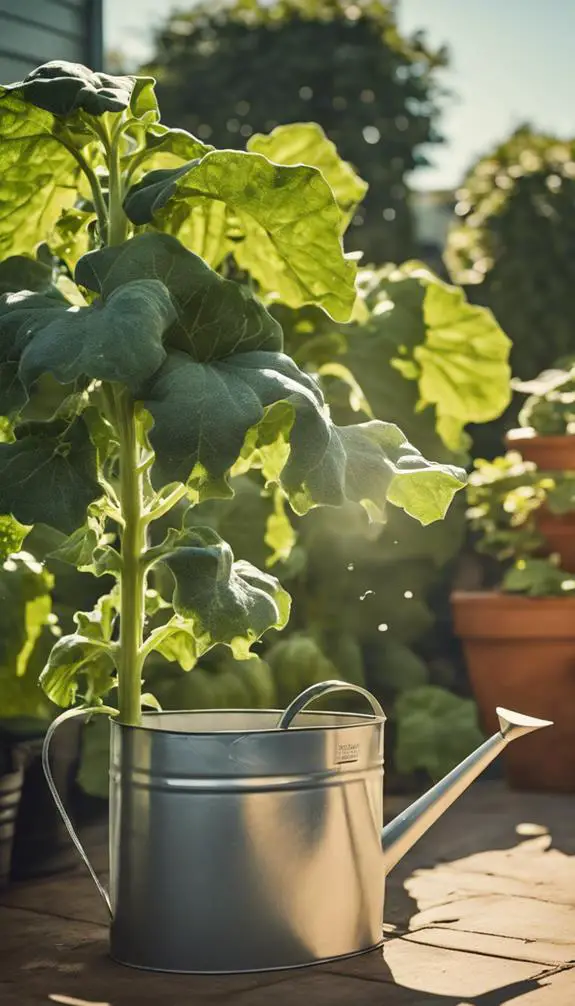
Every few weeks, you'll need to fertilize your squash plants to maintain their vigor and promote healthy fruit production.
A balanced fertilizer with a ratio of 5-5-5 (nitrogen-phosphorus-potassium) is suitable for squash. You can also opt for foliar feeding, which involves spraying a diluted fertilizer solution directly on the leaves.
This method provides essential micronutrients and promotes healthy leaf growth. Verify your fertilizer is pH-balanced, as squash prefers a slightly acidic to neutral soil pH (around 6.0-7.0).
Avoid over-fertilizing, as this can lead to weak stem growth and reduced fruit production. Monitor your plants' response to fertilization and adjust your schedule accordingly.
Pruning for Better Yield

You'll want to prune your squash vines to promote healthy growth and encourage fruit production.
By removing weak or damaged vines, you'll direct the plant's energy towards producing more fruit.
Regular pruning will also help you maintain a tidy container and improve air circulation around the plant.
Promote Healthy Vines
By supporting and pruning your squash vines, you can encourage healthy growth and maximize your harvest.
As the vines grow, provide a trellis or cage for them to twine around, keeping the fruit off the ground and promoting better air circulation.
Regular vine pruning helps to direct the plant's energy towards fruit production and prevents overcrowding. Remove any weak or spindly vines, and trim back the tips of the main vines to encourage branching.
This will promote a bushier plant with more fruiting sites. Be sure to disinfect your pruning tools between cuts to prevent the spread of disease.
Encourage Fruit Production
Pruning plays a significant role in encouraging fruit production, as it allows the plant to focus its energy on developing fruit rather than vegetative growth.
By removing select leaves and stems, you're promoting fruit induction methods that stimulate hormone regulation. This process triggers the plant to allocate resources towards fruit development, resulting in a higher yield.
When pruning, target any weak or spindly growth, as well as any branches that are growing inwards or crossing over others. This will allow the plant to direct its energy towards producing healthy, robust fruit.
Managing Pests and Diseases
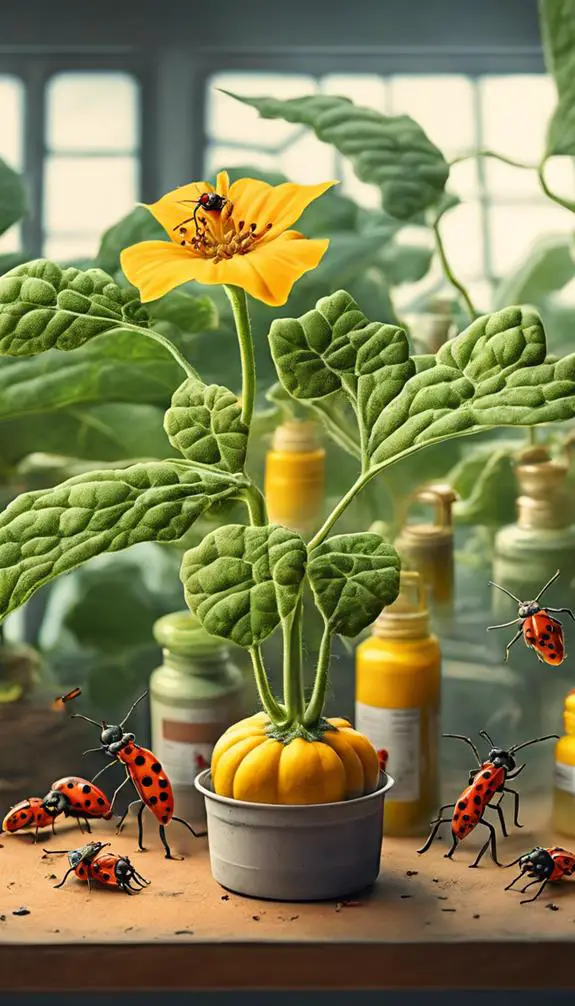
While squash plants thrive in containers, they're not immune to pests and diseases that can quickly devastate your harvest.
You'll need to take proactive measures to prevent infestations and infections. Use pest barriers like fine-mesh screens or row covers to keep whiteflies, aphids, and squash bugs at bay.
Select disease-resistant squash varieties to reduce the risk of fungal and bacterial infections.
Inspect your plants regularly for signs of trouble, such as yellowing leaves, black spots, or powdery mildew. Remove infected leaves or stems to prevent the disease from spreading.
Keep your container clean, and avoid overwatering, which can exacerbate disease issues.
Training Vines and Stems
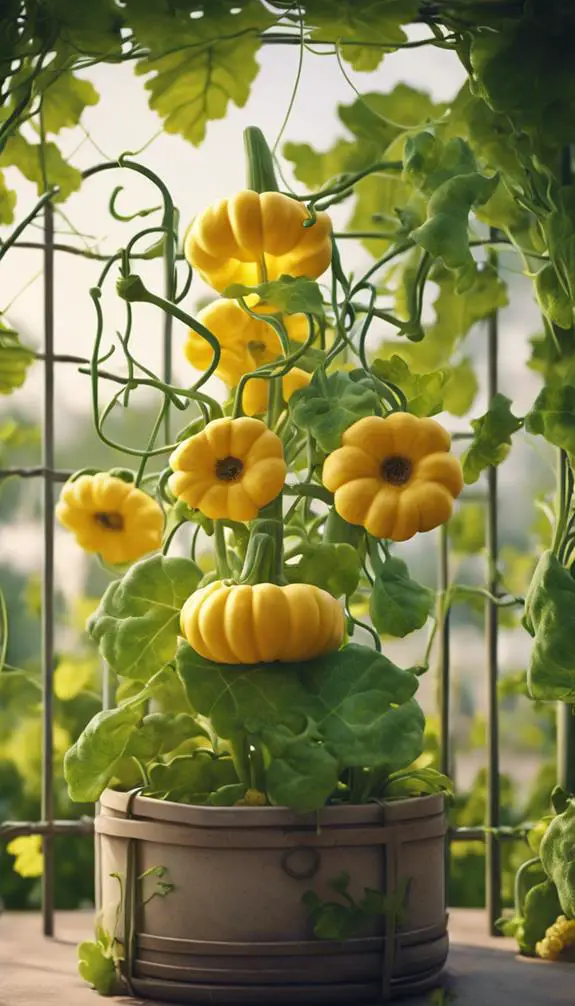
With their natural inclination to spread out, squash vines and stems can quickly overtake a container, making it essential to provide support and direction.
You'll need to train your squash vines to grow upwards using trellises, arbors, or other stem supports. This won't only keep your container organized but also promote better air circulation and sunlight penetration.
As your vines grow, you'll need to prune them regularly to encourage bushy growth and prevent overcrowding. Remove any weak or spindly vines, and trim back the tips to encourage branching.
Regular vine pruning will also help control the spread of disease and pests. By providing the right support and direction, you'll be rewarded with a healthy and productive squash harvest.
Harvesting Ripe Squash

After months of nurturing, your squash plants have finally produced a bounty of fruit, and it's time to reap the rewards of your labor.
Now, it's vital to inspect your squash regularly to determine the perfect harvest timing. Check for ripeness by gently tugging on the fruit; a ripe squash will come off the vine easily.
Also, inspect the stem attachment; a dry, brown stem indicates readiness. Harvest summer squash when it's young and tender, as it will continue to produce throughout the season.
For winter squash, wait until the rind is hard and the stem is dry. Correct harvest timing guarantees you'll enjoy the best flavor and texture from your container-grown squash.
Common Problems to Watch
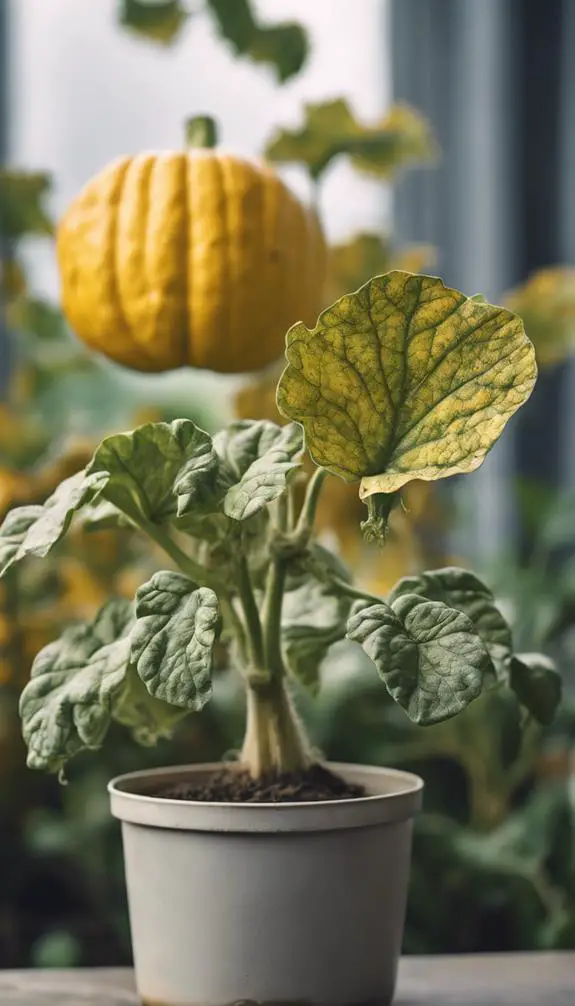
You've invested time and care into growing squash in containers, but even with your best efforts, problems can arise.
Keep an eye out for squash pests like aphids, whiteflies, and spider mites, which can weaken your plants and reduce yields. Regularly inspect your containers for signs of infestation, and use organic pest control methods when necessary.
Container constraints can also hinder squash growth, such as limited soil volume, inadequate drainage, and insufficient sunlight.
Guarantee your containers have good drainage holes and are at least 5-7 gallons in size to accommodate your squash plants' root systems.
Provide full sun and maintain ideal soil temperatures to promote healthy growth.
FAQs
Can I Grow Squash in a Container on a Balcony With High Winds?
On your windy balcony, you'll need to provide protection for your container squash. Consider installing wind screens or balcony protection, like trellises or windbreaks, to shield your plants from harsh gusts and guarantee a successful harvest.
How Often Should I Rotate My Squash Container for Even Growth?
You'll want to rotate your squash container every 2-3 days to guarantee even growth, adjusting the direction to face the sun, and repositioning the container to compensate for wind direction, promoting symmetrical fruit development.
Can I Reuse Container Soil From Last Year's Squash Plant?
You shouldn't reuse last year's container soil, as it may harbor pathogens and exhibit soil degradation, potentially harming your new squash plant; instead, start fresh with a well-draining mix to guarantee prime growth and minimize disease risks.
Will Squash Plants Grow Well in a Shaded Area With Indirect Sunlight?
You'll find that shaded squash growth is possible, but it's vital to provide partial sunlight, as squash requires at least 4 hours of direct sun or 6 hours of indirect light to thrive, so consider a spot with dappled shade.
Can I Transfer Squash Plants From Containers to a Garden Bed?
You can transfer squash plants from containers to a garden bed, but minimize squash transplant shock by acclimating them to outdoor soil conditions over 7-10 days, ensuring a smooth shift and ideal growth.
Conclusion
You've successfully grown squash in a container! Now, enjoy your harvest, knowing you've provided the right conditions for your squash to thrive. Remember to store winter squash in a cool, dry place to keep it fresh for months. With proper care, you can enjoy a bountiful squash harvest from the comfort of your own backyard or balcony.



